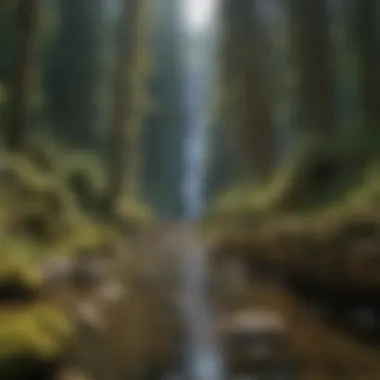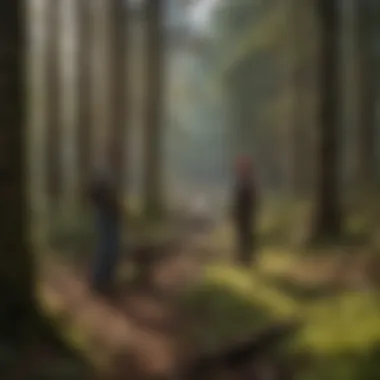Snoqualmie Region: Ecology, Culture, and Forestry


Intro
Snoqualmie, located in Washington State, is a region that is as breathtaking as it is ecologically significant. Nestled in the Cascade Mountains, it boasts a rich tapestry of biodiversity and a strong cultural heritage. The area not only serves as a habitat for numerous species but also stands as a testament to sustainable forestry practices adopted by its communities. Understanding Snoqualmie's intricate ecosystem is crucial for fostering effective conservation methods while also promoting the importance of local engagement in maintaining its natural beauty.
In this exploration, we will delve deeper into the various facets of Snoqualmie, starting with its forest ecology and biodiversity. We will discuss why these ecosystems are vital, identify the flora and fauna that thrive there, and examine how sustainable forestry practices are implemented on the ground. Furthermore, we will consider the active role local communities play in stewardship initiatives, showcasing their commitment to preserving this spectacular environment for future generations.
Prologue to Snoqualmie
Understanding Snoqualmie is like peeling back the layers of an ever-evolving tapestry. Each thread tells a story of rich ecology, cultural heritage, and a unique way of living in harmony with nature. This article aims to shine a light on the importance of Snoqualmie as not just a geographical location but as a focal point for conservation and sustainable practices. For forestry professionals and academia alike, diving into the depths of Snoqualmie could provide critical insights into balancing economic needs with environmental stewardship.
Geographical Overview
The Snoqualmie region, nestled in the shadow of the Cascade Mountains in Washington State, is a physiographic marvel. With its cascading waterfalls, lush forests, and meandering waterways, the geography is diverse and often breathtaking. This area boasts a habitat that ranges from moist lowland forests to the alpine meadows found at higher elevations.
- Mount Si stands tall, acting as a guardian over the landscapes.
- Snoqualmie Falls, with its plunging waters, attracts attention not just for its beauty but also as a central point in the region's hydrology.
The ecosystem is further enriched by the Snoqualmie River, which meanders through valleys and provides vital resources for wildlife and human communities. This geographic diversity plays a crucial role in sustaining varied flora and fauna, making the region both ecologically and culturally significant.
Historical Significance
History stands as a testament to the evolution of human interaction with this landscape. The Snoqualmie Valley has been inhabited for thousands of years by indigenous tribes. The Snoqualmie Tribe, a key player in this region, has a rich cultural heritage that reflects deep ties to the land. Their stories are embedded in the sites around, many of which are essential to their spiritual and communal practices.
The early days of Snoqualmie were marked by a connection with the land that was symbiotic in nature. The lush forests provided not only shelter but also resources for sustenance.
"Preserving the land means preserving our past, present, and future." - A tribal leader’s perspective captures the essence of local understanding.
As logging emerged in the late 19th century, it brought transformational changes. The timber industry fueled economic growth but also caused strains on the natural environment. Understanding how these historical tides have shaped the region can provide essential context for contemporary conservation efforts. The layers of history here invite a closer examination—each grain of wood tells a tale of what once was and what could still be.
Ecological Features of Snoqualmie
The ecological features of Snoqualmie are not just the backdrop for picturesque views; they're the lifeblood of the valley. Understanding these traits is vital as they illustrate the interdependence of species, the effects of human activity, and the necessity of conservation efforts. This unique region is characterized by its diverse flora and fauna, intricate watershed systems, and distinct ecosystems that collectively create a dynamic natural environment.
Flora and Fauna Diversity
Snoqualmie is home to a broad range of plant and animal life, courtesy of its varied climates and topographies. From the lush forests to the meandering rivers, the diversity is impressive. The valley features towering conifers like Douglas firs and western red cedars, whose canopies provide habitat to a range of bird species and small mammals. In addition, wildflowers dot the landscape in spring and summer, painting the ground in vibrant colors.
Animal life flourishes as well. Species like elk and deer roam the forested regions, while streams are alive with fish such as salmon and trout. The richness of biodiversity here offers essential insights into the health of the ecosystem. As communities across the globe grapple with environmental degradation, preserving this balance is more important than ever.
"This valley is a tapestry of life, woven from the threads of countless organisms. Its diversity is not just a beauty to behold, but an indicator of ecological well-being."
Watershed Dynamics
The Snoqualmie region is anchored by its watershed, which plays a critical role in maintaining the health of the ecosystem. The flow of water nourishes the forests, supports wildlife, and feeds into rivers that are pivotal for salmon migration. A watershed acts as a natural filtration system, purifying water while also providing necessary resources to various life forms.
Understanding watershed dynamics in Snoqualmie is crucial particularly regarding water conservation efforts. As urbanization increases, preserving these waterways and their tributaries becomes a challenge. Implementing strategies that protect these sources not only benefits local ecosystems but also ensures a sustainable future for community water supplies.
Unique Ecosystems
Each corner of Snoqualmie features ecosystems that are not merely variations of one another but uniquely adapted to their specific environments. From wetlands to alpine meadows, these areas play distinctive roles. Wetlands, for instance, act as natural sponges, absorbing excess rainwater and providing breeding grounds for many aquatic species. Meanwhile, alpine meadows are a haven for plant species that are specialized for higher elevations and cooler temperatures.


The interplay among these ecosystems invites a closer look at how they depend on one another. The health of one ecosystem can dramatically influence another, exemplifying the delicate balance of nature. Understanding this interconnectedness is essential for effective stewardship and maintaining ecological integrity.
Cultural Heritage of the Snoqualmie Valley
The Snoqualmie Valley is not only a hub of natural beauty but, importantly, a tapestry woven with cultural narratives that have shaped its community identities over centuries. Understanding the cultural heritage here is crucial as it highlights the interrelationship between the people and the land they inhabit. Indigenous tribes played a significant role in establishing the foundations of the valley's culture, which manifests through language, traditions, and communal practices that are still resonant today. By exploring this heritage, we gain insight into sustainable living practices that have been passed down through generations, emphasizing respect for the environment, which is especially relevant to today’s forestry professionals and academics.
Indigenous Tribes and Their Legacy
The Snoqualmie Valley is deeply intertwined with the history and heritage of the Snoqualmie Tribe and other Indigenous peoples. These tribes have lived in harmony with the land for thousands of years, adapting their cultures to the rhythm of natural cycles. Fishing, for example, was not just a means of survival but a sacred practice that involved ceremonies and rituals. This legacy of stewardship showcases an understanding of the ecological systems long before contemporary practices emerged.
Echoing their voices, the tribes emphasize the importance of the land through traditional stories passed down orally. Locations such as Snoqualmie Falls are imbued with cultural significance, said to be home to the spirits of their ancestors. Understanding these connections can inform current conservation efforts by integrating Indigenous knowledge and worldview.
"To truly appreciate Snoqualmie, we must listen to the stories of those who have walked this land long before us."
Cultural Practices and Traditions
The cultural practices of the tribes are rich with diversity and deeply rooted in the area’s ecosystem. Art forms such as basket weaving, carving, and beadwork are not just crafts; they are expressions of the identity and historical ties of the people to the valley. Song and dance play pivotal roles during community gatherings or seasonal celebrations and are reflective of the changing environments around them.
In addition, the concept of the land as a relative—or a living entity to be respected and nurtured—is mirrored in their agricultural techniques. Many Indigenous peoples practiced controlled burning and selective harvesting, fostering resilience within the forest systems. This approach contrasts sharply with modern practices that often prioritize immediate gains over long-term sustainability.
By examining such profound connections to the cultural heritage of the Snoqualmie Valley, forestry professionals today can learn valuable lessons on maintaining balance and stewardship in the face of evolving challenges.
Economic Aspects of Forestry in Snoqualmie
The economic landscape of Snoqualmie is intricately woven into its forestry practices. The timber industry not only plays a crucial role in the local economy but also contributes significantly to regional employment and commerce. As one ponders the relationship between economic vitality and sustainable forestry, it's clear that understanding this interplay is essential for stakeholders—ranging from policymakers to community members interested in safeguarding Snoqualmie’s rich natural resources.
Timber Industry Overview
When considering the timber industry in Snoqualmie, one sees a dual narrative: the need for economic development and the imperative of environmental stewardship. The region's abundant forest land has historically been a source of timber, driving industrial growth and providing jobs for generations. Today, the industry comprises both large-scale operations and small family-owned businesses, reflective of a diverse economic base.
The local timber market showcases a multitude of wood products, from lumber to plywood and specialty items. Recent statistics reveal that Snoqualmie's timber exports contribute significantly to the state's gross revenue, ensuring that communities thrive while managing sustainable harvest rates. However, it’s worth mentioning that timber companies must balance their operations with conservation efforts to mitigate ecological disruption. The following points outline this sector’s broad significance:
- Job Creation: The timber sector employs hundreds of individuals, presenting opportunities in forestry management, logging, and processing.
- Economic Multiplier Effects: Local businesses, supporting industries, and services benefit from the timber industry’s activities, fostering a thriving economic ecosystem.
- Resource Sustainability: With responsible management practices, Snoqualmie can maintain its timber supplies while preserving the environment for future generations.
Sustainable Practices in Forestry
As concern over climate change and environmental degradation intensifies, sustainable forestry practices have gained paramount importance in Snoqualmie. The fundamental goals of sustainability in this context involve managing forest resources to meet present needs while ensuring ecological balance and the needs of future generationsare also met.
Snoqualmie has embraced several sustainable practices aimed at preserving forest integrity while promoting economic growth:
- Selective Logging: This method minimizes damage to the surrounding ecosystem, allowing for healthier regeneration of flora and fauna. It involves removing only certain trees, thus maintaining biodiversity and stabilizing soil erosion.
- Reforestation Programs: These initiatives aim to replenish the forests by planting native species, ensuring that the ecosystem remains resilient against external pressures.
- Climate-Conscious Harvesting: Forest managers are increasingly adopting climate-adaptive practices. They assess the potential impacts of climate change on growth patterns and species selection to ensure longevity and productivity.
“Sustainable forestry is not merely an option; it’s a necessity for a region like Snoqualmie that holds such ecological and economic significance.”
- Certification Programs: Many local forest products undergo certification to assure consumers of ethical and sustainable sourcing. This not only boosts marketability but also aligns business practices with sustainability principles.
Snoqualmie Valley Conservation Efforts
Conservation efforts in Snoqualmie Valley are not just a nice-to-have; they are a necessity for maintaining the ecological balance, cultural integrity, and economic viability of the region. As this area continues to face pressures from urban development and climate change, taking charge of conservation is crucial. These efforts encompass a variety of projects aimed at preserving the natural beauty, biodiversity, and cultural heritage of Snoqualmie. They rest on the principles of sustainability and active community engagement, fostering a sense of stewardship among residents.
Community Engagement in Conservation


When it comes to conservation in Snoqualmie Valley, the bedrock of success often lies with the people. Community engagement has shown to be vital in many initiatives, as it harnesses the passions and insights of locals who care deeply about their environment.
Local groups often organize clean-up days, tree planting events, and educational workshops that aim to raise awareness around preserving natural habitats. For example, projects like the Snoqualmie Valley Community Network work tirelessly to involve residents in conservation activities.
These initiatives benefit everyone involved, as they build stronger relationships among community members. They also create a rich tapestry of stories and traditions that are vital to the area’s identity. Educating the younger generation plays a pivotal role as well—children who participate in these projects are more likely to grow into eco-conscious adults. Engagement, both meaningful and constructive, helps bridge the gap between need and action.
"Community participation is the heartbeat of conservation; when locals become invested, the land flourishes."
Role of Non-profit Organizations
Non-profit organizations have become pillars in the fight for conservation in Snoqualmie Valley. These groups often bring different expertise and resources together to tackle various environmental issues. For instance, organizations like the Mountains to Sound Greenway Trust focus on land preservation, connecting communities with nature while maintaining biodiversity.
These non-profits serve several roles:
- Advocacy: They lobby for policies that favor conservation.
- Funding: Many non-profits secure grants and donations that fund restoration projects.
- Education: By providing resources and raising awareness, they help cultivate an informed public.
In recent years, partnerships have formed between local non-profits and citizens to propel conservation forward. These collaborations often lead to innovative projects that incorporate sustainable forestry practices, trail development, and wildlife habitat restoration. By offering volunteer opportunities, these organizations invite community participation, ensuring that people not only hear about conservation but actively partake in it.
In summary, the united efforts of communities and non-profit organizations in Snoqualmie Valley yield notable benefits for both the environment and its inhabitants. Together, these entities work tirelessly to ensure that the region’s unique ecological and cultural heritage is cherished and preserved for future generations.
Impact of Climate Change on Snoqualmie
The Snoqualmie region stands at the precipice of significant environmental shifts, making it crucial to examine the impact of climate change here. This region, with its lush forests and diverse ecosystems, is not just a scenic attraction; it is an intricate web of life that depends on stable climatic conditions. As temperatures rise and weather patterns become more unpredictable, the implications for Snoqualmie’s ecology, economy, and community are profound. Understanding these impacts will help inform better stewardship practices and sustainable development strategies, ensuring that Snoqualmie remains a resilient landscape in the face of looming changes.
Changing Weather Patterns
Snoqualmie is experiencing alterations in its weather patterns, which can be traced to global climate change trends. Rainfall variability has notably increased, leading to wetter winters and reduced snowfall at lower elevations. This fluctuation challenges the seasonal balance that local flora and fauna have adapted to over centuries. For instance, many plant species rely on a predictable snowpack to nourish their roots during the slow thaw of spring—a cycle that is currently in jeopardy.
Drier summers are becoming more prevalent, which places additional stress on the forest ecosystems. With temperatures creeping up, the risk of wildfires has intensified. Forests that once thrived in balanced moisture conditions are now more susceptible to fires, threatening not just wildlife but also air quality and human safety in surrounding areas.
- Here are some specific aspects of the changing weather patterns in Snoqualmie:*
- Increased Rainfall: Higher precipitation can lead to increased erosion and landslides
- Variable Snowpack: Alters water availability for streams and rivers
- Rising Temperatures: Contributes to drought conditions
In sum, the weather patterns shifting in Snoqualmie is like a double-edged sword: while some species may adapt, others struggle to cope, leading to potential imbalances in the ecosystem.
Effects on Local Ecology
The ecological consequences of climate change in the Snoqualmie region are extremely concerning. As temperature and moisture patterns shift, many organisms are forced to adapt or face extinction.
- Flora: Some plants may find it difficult to thrive in the changing climate. For instance, the iconic western red cedar and Douglas fir are native trees essential to local biodiversity. However, changes in moisture levels can stunt their growth and reproductive capabilities.
- Fauna: Local animal species are also feeling the pinch. Salmon, for instance, depend on consistent cold water to spawn; warmer stream temperatures jeopardize their life cycle. As streams warm, this fish population can drop dramatically, disrupting the entire food web that relies on these fish.
"Climate change isn't just an abstract concept; it's a real and immediate threat to the Snoqualmie region's biodiversity, economy, and community resilience."
The interconnectedness of these effects means that as certain species decline, the impact ripples through the entire ecosystem. Species that depend on each other may find their relationships strained or severed, leading to a possible collapse of ecological balance within the region.
Research and Studies Focused on Snoqualmie
The Snoqualmie region has long drawn attention from researchers and environmentalists alike, carving a niche as a focal point for various studies. This research is pivotal not just for academic insights but also for understanding real-world ecological dynamics. The investigations done here often center on complex ecosystems, offering a rich tapestry of data that aids in grasping how natural phenomena interact with human activities. Moreover, the studies contribute significantly to conserving this unique landscape, emphasizing the decision-making processes regarding resource management and sustainability.
Recent Scientific Contributions
Recent scientific efforts shed light on the multifaceted ecological attributes of Snoqualmie. For instance, studies focusing on biodiversity assessment have revealed a plethora of species previously underestimated in number. Researchers have ventured into the towering trees and lush underbrush, cataloging both common and rare species, which has contributed to the ongoing conservation endeavors.


Another noteworthy contribution comes from hydrological studies that have evaluated the impact of rainfall on the Snoqualmie River's health. By employing advanced modeling techniques, scientists can predict flooding events and assess water quality over time, thus informing both local governance and public awareness. Such research holds immense value; it fosters a sense of responsibility among stakeholders about surrounding ecosystems.
"Understanding the intricacies of Snoqualmie's ecology positions us better to safeguard its future and employ sustainable practices that truly work."
Collaborative Research Initiatives
Collaboration has taken root in the Snoqualmie region, bringing together various entities with a shared objective: preserving its ecological heritage. These initiatives often involve universities, local government bodies, and non-profit organizations, weaving a network of expertise and resources focused on addressing environmental challenges. For example, the partnership between University of Washington and various conservation groups has led to innovative research methods aimed at studying climate change impacts on the area. This alliance enables a comprehensive approach that unites theoretical frameworks with practical solutions.
Furthermore, community-driven research efforts are emerging as a vital component in stewardship processes. Local residents, empowered through workshops and training events, are increasingly participating in habitat restoration projects and data collection. This grassroots involvement not only creates a bond between the community and the land but also enhances public support for scientific studies, as data gathered reflects local knowledge and concerns firsthand.
Through these concerted efforts, the Snoqualmie region stands as a living laboratory, where science and community intersect to forge pathways for sustainable development and conservation.
Challenges Facing the Snoqualmie Region
When examining the complexities of Snoqualmie, two pressing challenges emerge: the impacts of urbanization and the threats posed by invasive species. Understanding these challenges is critical as they shape the landscape of Snoqualmie and the effectiveness of conservation efforts.
Urbanization Pressures
Urban encroachment in Snoqualmie crafts an intricate narrative, where the expansion of human settlement wields significant consequences on local ecology. The scenic vistas that define Snoqualmie draw people in, leading to increased housing developments and infrastructure growth. While this brings an economic boost, it also imposes stress on natural habitats.
Some of the key issues linked to urbanization include:
- Habitat Fragmentation: As homes and roads spring up, wildlife habitats become segmented. Many species may struggle to navigate these artificial barriers.
- Pollution: Urban development often comes hand-in-hand with pollutants that leach into soils and waterways, further endangering biodiversity.
- Water Resource Management: The more built-up areas expand, the greater the strain on local water sources. This can lead to conflicts between human and ecological water needs.
Local communities, conservationists, and government bodies must collaborate to create sustainable urban planning initiatives. These initiatives can encourage a balance, looking to protect the beautiful landscapes while accommodating the growing population's demands.
"Snoqualmie stands at a crossroads, where the flourishing metropolis meets unspoiled nature. The future is contingent on wise decisions made today."
Invasive Species Threats
The introduction of invasive species to Snoqualmie presents another hurdle that demands immediate attention. Such species can disrupt ecosystems, out-competing native flora and fauna, ultimately leading to diminished biodiversity.
Specific examples of the impact include:
- Plant Overgrowth: Non-native species like Himalayan blackberry outgrow local natives, crowding them out and altering the landscape.
- Wildlife Displacement: Invasive animals may not only compete for resources but can also introduce diseases that native populations aren't equipped to handle.
Combatting invasive species requires ongoing vigilance and aggressive action by both community members and environmental agencies. Strategies may include education to raise awareness about local ecosystems and direct efforts to remove or mitigate the spread of invasive species.
Future Perspectives on Snoqualmie Stewardship
Snoqualmie, known for its breathtaking landscapes and rich cultural heritage, stands at a crucial juncture concerning its stewardship. This region's future perspectives revolve around the careful balance between preservation and sustainable development. Realizing the full potential of Snoqualmie’s natural resources while ensuring ecological integrity becomes increasingly pertinent in today’s changing environment.
Innovative Forestry Practices
The focus on innovative forestry practices is vital for fostering a sustainable relationship between the community and the forests. Embracing new methodologies can lead to a more resilient ecosystem, benefiting both wildlife and local economies. Some practices that show promise include:
- Agroforestry Techniques: Integrating agriculture and forestry can bolster biodiversity while providing economic benefits to local farmers. This symbiotic relationship helps in maintaining healthier soil and reducing erosion.
- Selective Logging: Rather than clear-cutting large areas, selective logging allows for the harvesting of mature trees while preserving younger ones, maintaining habitat for various species and promoting regeneration.
- Restoration Thinning: This practice aims at reducing tree density in overstocked areas, which not only improves forest health but also enhances the growth of remaining trees.
These innovations are not just trendy; they’re essential components of modern forestry that promote long-term sustainability.
Vision for Sustainable Development
Having a vision for sustainable development in Snoqualmie means prioritizing the ecological, social, and economic aspects of the region. To effectively marry these elements, several principles should be considered:
- Community Involvement: Local residents should have a say in decision-making processes. Their knowledge and connection to the land provide insights that outsiders may overlook.
- Job Creation through Sustainability: Investing in green jobs, like restoration projects or eco-tourism, provides employment while conserving the environment. A skilled workforce creates opportunities for locals to engage with their surroundings positively.
- Resource Management Plans: Comprehensive resource management plans that take climate adaptation into account can mitigate the challenges posed by weather fluctuations. These plans could focus on maintaining water quality and addressing the risk of invasive species.
- Partnerships with Organizations: Collaborating with non-profits and academic institutions enhances knowledge sharing and access to funding opportunities. This also fosters a culture of stewardship aligned with the latest advancements in conservation science.
"The strength of Snoqualmie’s future lies in the hands of its community and stakeholders. Their actions today determine the health of this unique ecosystem for generations to come."















